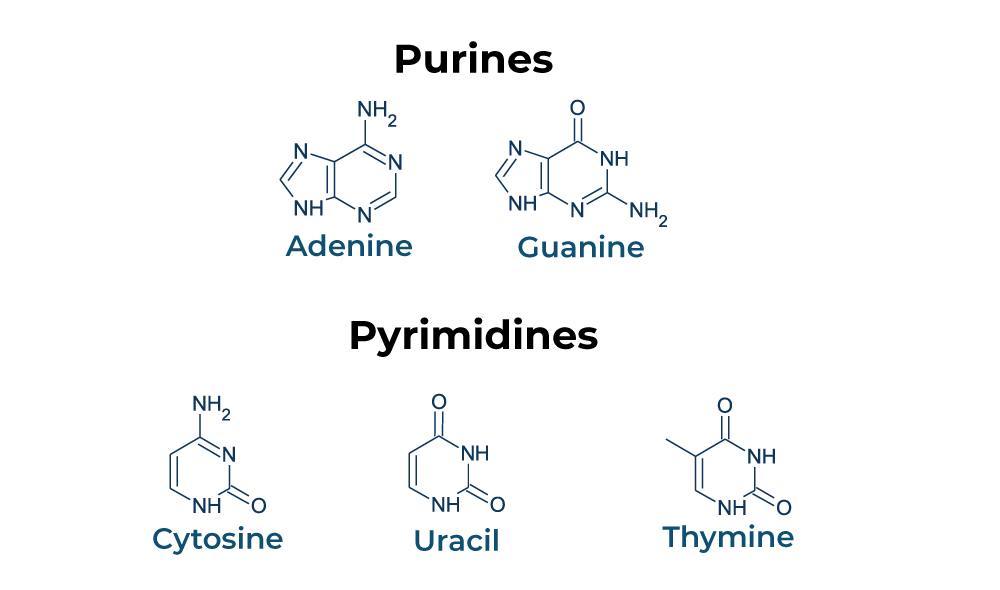DNA and RNA are two vital molecules that play a crucial role in the storage and transmission of genetic information. These molecules are composed of smaller units called nucleotides, which consist of a sugar molecule, a phosphate group, and a nitrogenous base. The nitrogenous bases are further classified into two categories: purines and pyrimidines. In this article, we will explore the difference between purines and pyrimidines, their structures, functions, and their significance in DNA and RNA.
For readers delving into the purines and pyrimidines and interested in broader biological topics, our lipids and animal cell pages serve as insightful references.
An Introduction to the Difference between Purines and Pyrimidines
Purines and pyrimidines are organic compounds that serve as the building blocks of DNA and RNA. They are nitrogenous bases that form the nucleotide units of these genetic molecules. Purines and pyrimidines are essential for the synthesis of DNA and RNA, which are responsible for storing and transmitting genetic information.
What are the Purines?
Purines are one of the two types of nitrogenous bases found in DNA and RNA. They have a double-ring structure that consists of a pyrimidine ring fused with an imidazole ring. The two purines found in DNA and RNA are adenine (A) and guanine (G). These nitrogenous bases are crucial for the formation of hydrogen bonds between complementary base pairs, which help stabilize the double helix structure of DNA.

What are the Pyrimidines?
Pyrimidines are the other type of nitrogenous base found in DNA and RNA. They have a single-ring structure consisting of a six-membered ring. The three pyrimidines found in DNA and RNA are cytosine (C), thymine (T), and uracil (U). Cytosine and thymine are found in DNA, while cytosine and uracil are found in RNA. The nitrogenous base pairing rules dictate that adenine pairs with thymine (or uracil in RNA) and cytosine pairs with guanine.

Difference between Purines and Pyrimidines
Structure
The most significant difference between purines and pyrimidines lies in their structure. Purines have a double carbon-nitrogen ring with four nitrogen atoms, while pyrimidines have a single carbon-nitrogen ring with two nitrogen atoms. The additional ring in purines makes them larger in size compared to pyrimidines.
Function
Both purines and pyrimidines have similar functions. They are vital for the production of DNA and RNA, as well as for the synthesis of proteins, starches, and other cellular components. Purines and pyrimidines also serve as a form of energy for cells and play a role in regulating enzymes and cell signaling.
Nucleobases
Purines consist of two nucleobases: adenine and guanine. These purine bases are found in both DNA and RNA. On the other hand, pyrimidines consist of three nucleobases: cytosine, thymine, and uracil. Cytosine is present in both DNA and RNA, while thymine is specific to DNA and uracil is specific to RNA.
Synthesis
Purines and pyrimidines are synthesized through different pathways. Purines are mainly synthesized via the salvage pathway, where preformed purine bases are converted into nucleotides. Pyrimidines, on the other hand, are primarily synthesized through the de novo pathway, where simple precursors are used to build pyrimidine rings.
For a detailed comparison between purines and pyrimidines, refer to the table below:
Types of Purines and Pyrimidines
Purines and pyrimidines are further classified into specific nucleobases. Purines include adenine and guanine, while pyrimidines consist of cytosine, thymine (DNA), and uracil (RNA).
Similarities Between Purines and Pyrimidines
Despite their structural differences, purines and pyrimidines share several similarities. Both purines and pyrimidines are essential for the production of DNA and RNA, as well as for the synthesis of proteins, starches, and other cellular components. They also serve as a form of energy for cells and play a role in regulating enzymes and cell signaling.
Solved Examples on Purines vs. Pyrimidines
Let’s solve a few examples to test our understanding of the difference between purines and pyrimidines:
Example 1: Which of the following nitrogenous bases is found in both DNA and RNA?
A) Adenine B) Guanine C) Cytosine D) Thymine E) Uracil
Solution: The correct answer is A) Adenine. Adenine is a purine base that is found in both DNA and RNA.
Example 2: Which nitrogenous base pairs with thymine in DNA?
A) Adenine B) Guanine C) Cytosine D) Uracil
Solution: The correct answer is A) Adenine. Adenine forms a complementary base pair with thymine in DNA, while uracil pairs with adenine in RNA.
Example 3: Which nitrogenous base is specific to DNA and not found in RNA?
A) Adenine B) Guanine C) Cytosine D) Thymine E) Uracil
Solution: The correct answer is D) Thymine. Thymine is a pyrimidine base that is specific to DNA and is not found in RNA. RNA uses uracil instead of thymine.
How Kunduz Can Help You Learn the Difference between Purines and Pyrimidines?
At Kunduz, we understand the importance of a strong foundation in biology. That’s why we offer comprehensive learning resources to help you grasp complex concepts like the difference between purines and pyrimidines. Our expert instructors provide easy-to-understand explanations, interactive quizzes, and real-world examples to enhance your understanding.
Whether you’re a student preparing for exams or a lifelong learner looking to expand your knowledge, Kunduz is here to support your educational journey. Join us today and unlock your potential in biology and beyond.
